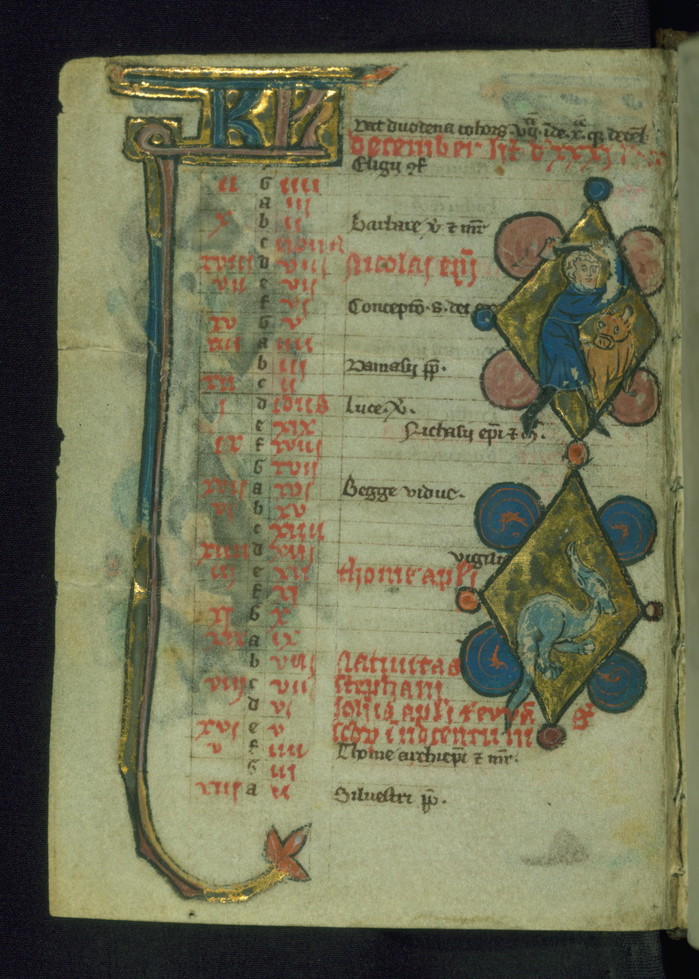A slew of Spanish Hours are coming in the near future, thanks to the detailed catalogue information in Josefina Planas’. Horae: el poder de la imagen : libros de hores en bibliotecas españolas. (Madrid: Orbis Mediaevalis, 2016). These are mostly not actually Spanish-made manuscripts, sadly, but a broad spectrum of French, Flemish, and Italian MS that are presently held in Spanish collections.
The first of these to be added is from the Biblioteca Nacional de Espagna, Vitr 23 10. This 13th C Parisian book is known as the Clinton Book of Hours, from the 15th C british owners. This manuscript starts with a long pictoral sequence, depicting two scenes of St. Edward the Confessor and then the life/death/resurrection of Jesus, leading to the calendar starting on f.29v.
The calendar itself is not graded, it uses gold and blue ink without obvious pattern. There is a tendency for lone important feasts to be gold, but when entries cluster they fall to simple alternation. Outside the main entries there are some of the Zodiac signs, 5 months, and many of the other informational notes (dates for easter and Rogation Keys). There are also several obituaries for members of the Clinton family in a later hand, in brown ink. The main entries are rather sparse, 142 dates populated, and most are the basic Parisian saints. With the exception of a row shift at the beginning of October(see f.37v below), the entries are accurate with only one incorrect entry elsewhere.
(DB Id: 279)
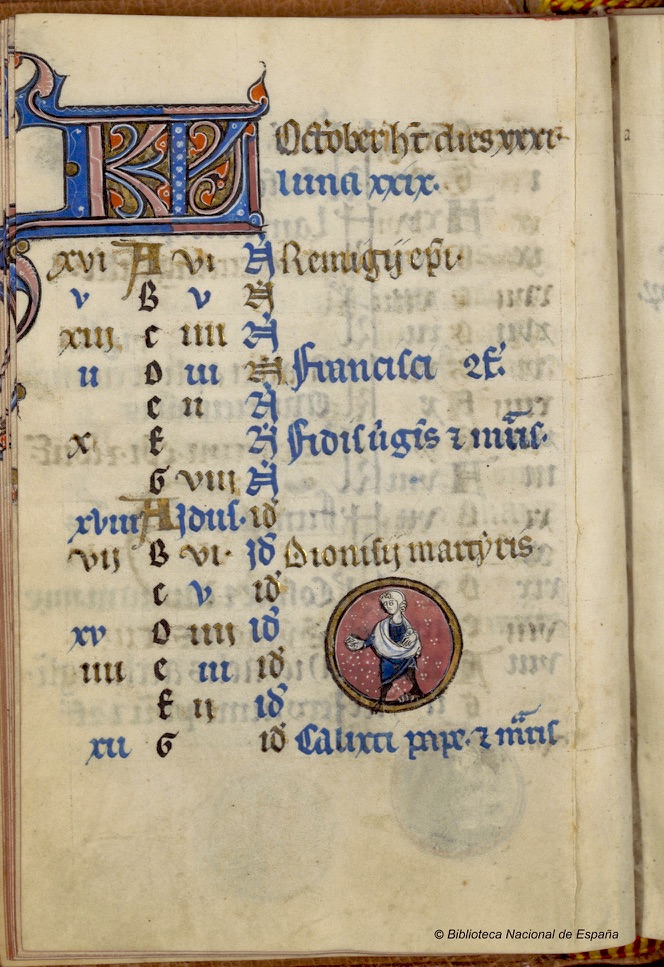
From the Bibliothèque nationale de France comes Latin 1173, the Hours of Charles d’Angoulême, made in France in the Late 15th C. Charles was the father of King François I(r. 1515-1547), and is identified by his arms on f.53r. The Hours are Use of Paris, but the calendar has not been localized.
Most of the literature on this MS is not focused on the text at all, but either the miniatures. Many of these are originals by Robinet Testard, but several are actually prints by Israel van Meckenem (signed IM), which have been colored and embellished by Testard. The calendar is populated with quite distinct illustrations. The labors of the month are unusual and 9 of the KL initials are formed by humans, often in brown/blue clothing, contorted and posing with strange beasts. May (f.3r below) is a representative example, with the woman seemingly unconcerned by the dragon attacking her to form the arms of the “K”. What seems to be the labor is, in fact, two “wild men” jousting
In the content of the calendar there are both some unusual saints listed as well as an interesting bit of scribal error. The calendar starts out mostly full, 27 in Jan, but immediately starts to open up, with only 12 in February. In January some of the entries are quite rare, eg. the heretofore unique 40 Martyrs (4294) on Jan 9.
The calendar starts out triple-graded, blue/red/black, and is carefully graded, several multiple-saint entries are graded distinctly for each saint. In November, however, the scribe seems to forget that he’s triple-grading, and starts to use red and blue in simple alternation when there are high-ranks. This was less definitive in early November, All Saints (2850) in blue vs. All Souls (2993) in red, but becomes more evident as the month proceeds. In December it is unavoidable with strict alternation of red/blue in the Christmas (814) through Holy Innocents (823) block. Were this still triple graded, Christmas, in red, would be outranked by the Holy Innocents and even St. Barbara (853), both in blue.
(DB Id: 278)
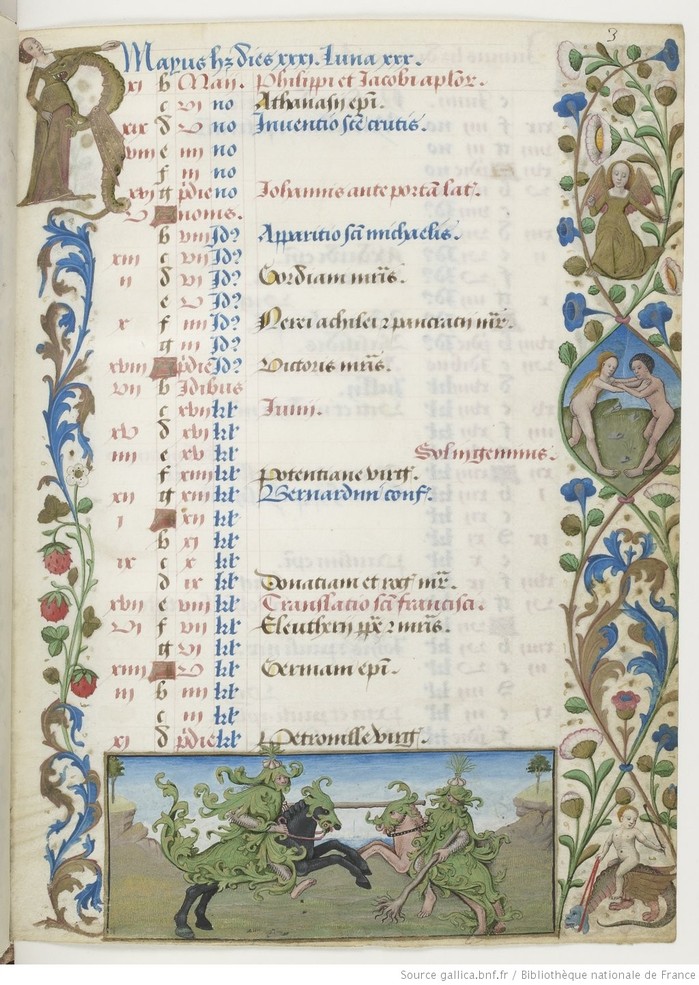
This is the most recent addition of a large block that I have not yet discussed. I am hoping to catch up on delayed commentary soon
Latin 3780, from the Biblioteca Apostolica Vaticana, is a late 15th C book made in Lyon, Use of Rome. We know it was made for one of the Italian merchants based in that city. It was made either in 1478 or 1479, based on a Golden Number table on f.14v which starts with the indications for 1479.
The calendar is very sparse, with 115 entries in total. There are very few distinctive entries, though St Livinus, bishop 288, on November 12 is uncommon. There are several unusual orthographies, Aghate for Agathe, and Ad cathedra petri for the more common Cathedra sci petri. Apart from a few instances of miscounting, there appear to be almost no errors, and no instances of a saint being bumped by a higher-ranked feast.
(DB Id: 276)
The concept of a manuscript Name has been in the DB from the beginning, but without a distinct field. The name was simply added as the first line in the Manusript Notes, set to display in Italics. It has now been moved to it's own field. What this means for users is that the MS Name appears in the main listing, under the shelfmark, and is used as the title in the single MS display as well as the compare. The relevant data has been munged in the backend DB
Manuscript Listing
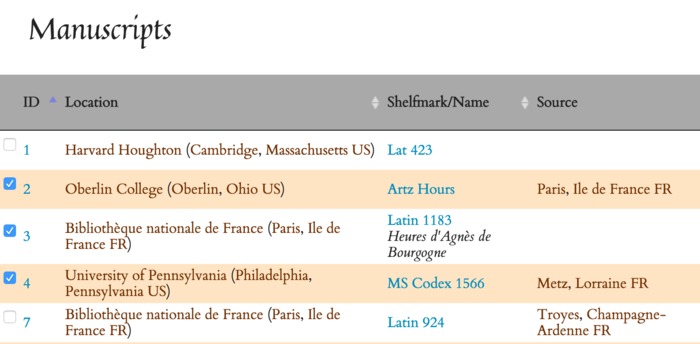
Compare Manuscripts. Notice that MS Codex 1566 has no name, so the shelfmark is used

The second manuscript from the backlog is from a new archive, the Beinecke Library at Yale, one of the largest collections of medieval manuscripts in the US. MS 663 is an early 16th Century Book from Tournai, now in Belgium. The calendar is almost entirely undecorated, only gold and colored KLs to start the month, but the overall manuscript has a large number of complex miniatures.
An interesting bit of scribal practice is revealed errors in the calendar. January begins on f.4v, so that each month is a complete opening, however the second half of January, properly f.5r, is on f.4r. This points to scribal error, possibly the scribe noticed that he had mis-copied Anthony (1272) as a Monk on January 17th, where he should be properly a Confessor, Abbot or Hermit. Since the recto was not needed before the start of January, he was able to save the parchment without the need to scrape it. Why the second half of the month would have been done before the start is unclear, but since the red ink is missing from f.4r, this seems more likely than that he put the first part of January on the back of the wrong leaf.
The calendar entries are extremely accurate, with only three noted errors, all of which are at the start of the month. Due to an error in the layout of the page, the short verses for June take up the space of the first of the month(see f.9v below). The entries for June 1 (Nicomedes) and 2 (Peter and Marcellini) were shifted to June 2 and 3, to compensate. More interesting is Brigid, usually February 1, appearing on January 31. Shifts across month divisions are extremely rare.
Finally there is a bit of a mystery in the calendar, October 9 has Bishop Dyonisus, the most common name for the date, in black ink, followed by a word I read as “mesda”, in red. I’ve been unable to find a useful meaning for this word.
(DB Id: 270)
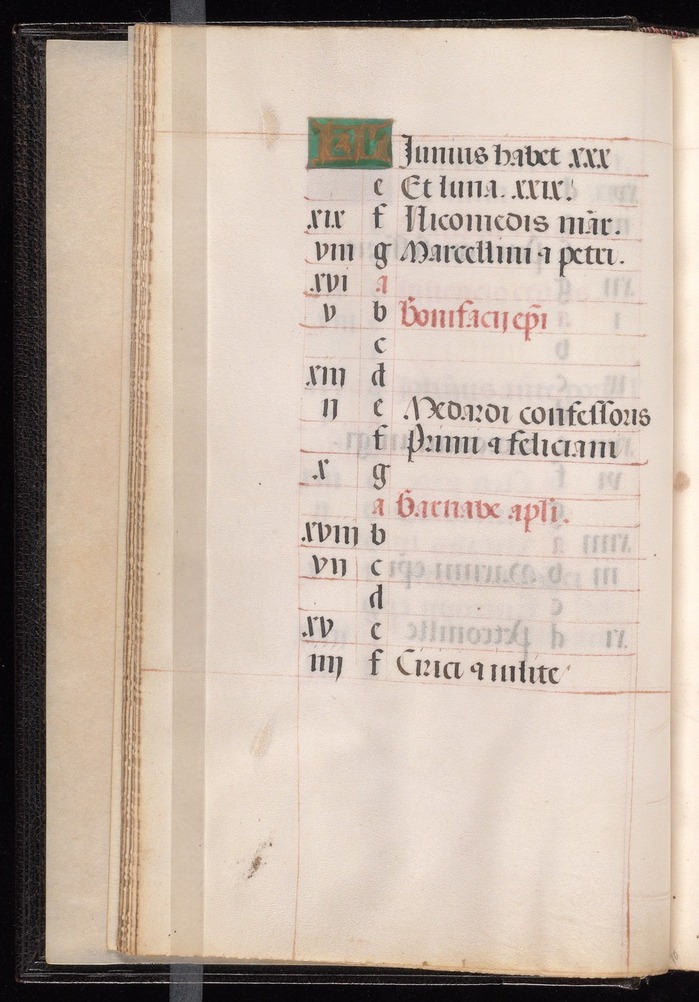
Catching up on some backlogged additions to the database.
First is up is Bibliothèque nationale de France, Latin 1171. This Hours Henri IV is unusual for the golden parchment used throughout the manuscript, every page of text is a matte gold, perhaps shell gold. The miniatures are done in a semi-gresaille style, with touches of gold and purple, and brown wash.
The calendar is complete and has an interesting scribal trick to handle the color of the entries. The feasts alternate red and blank ink evenly, with high-importance feasts identified by a larger, white, capitol letter to start them. This solves for the desire to keep the perfectly regular color pattern without loosing the indication of important feasts, cf. DB Id 266. There is some ambiguity in the Vigils, which are indicated with a white paraf mark before the word. I am treating these as “high” importance, but the paraf could indicate a medium range. Since these only appear on the Vigils, and appear on all of those, there is little additional data to use.
The calendar entries are in French and there are a surprisingly large number of unidentified saints, including some with unique names, Saint Feulgent on March 18 as an example (see f.2r below)
(DB Id. 162)
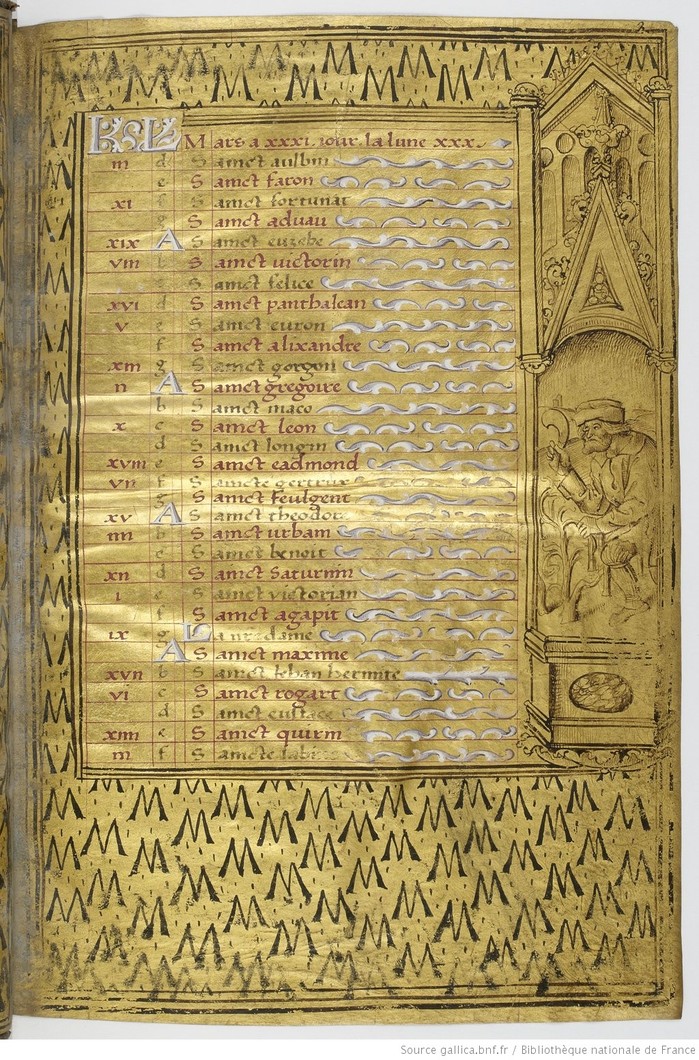
Another library joins the database with the addition of Ms.1185 from the Bibliothequè de l’Arsenal, located in Paris near the former site of the Bastille. This is a 15th C. Book from Cambrai, now in northern France. The book is in a very high quality bâtarde hand, with multiple flourished (nearly cadel) capitals in the calendar test. There are also illusionistic borders, with shell-gold backgrounds, on the outer edge of every page, both text and calendar, except for those with more complex decorative programs.
The text of the calendar is in French with some very specific-to-Cambrai entries, such as Bishop Gaugericus (feast in red on August 11 (370), Octave on August 18 (4007), elevation on September 24 (3803)).
An interesting variant is the indication of the Epiphany (January 6 (1488)) (see f.1r below). In French calendars this is usually spelled as La Tiphaine (or a varient thereof), however in MS.1185 it is spelled in hybrid La epyphanie n[ost]re s[iegneu]r. The article is never seen in Latin calendars, but neither Epyphanie nor vocal variants, are seen in French Calendars. The closest match to this entry, oddly, is the early 16th C. Ventian calendar in Houghton MS Typ.1000
(DB Id: 265)
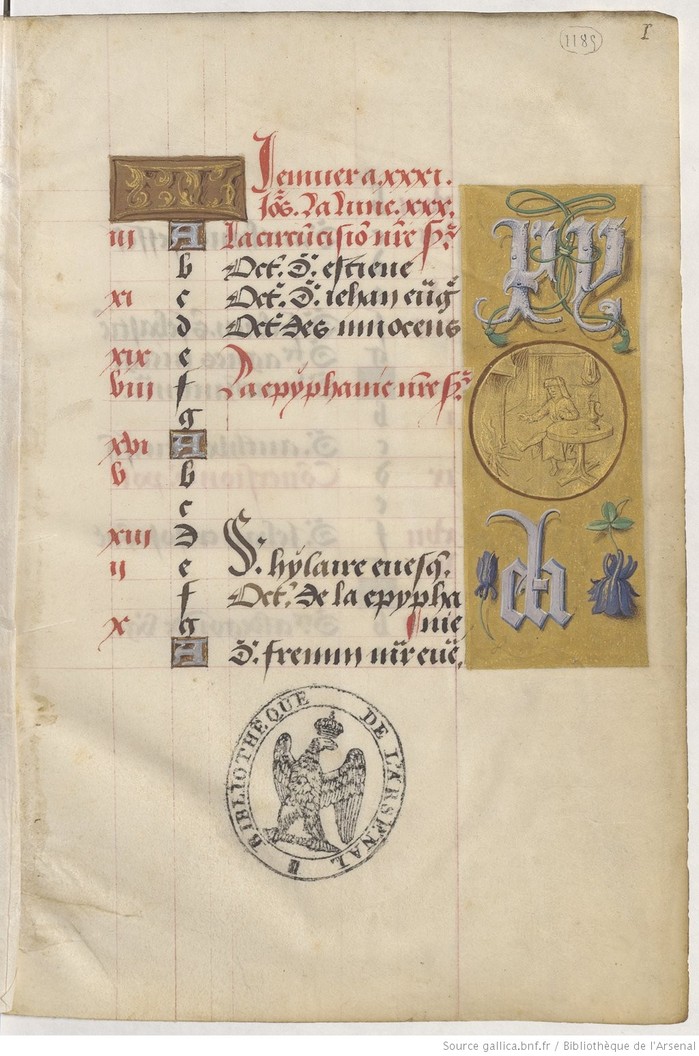
Utopia Cod.111 is one of the many Parisian Hours, but with an unusual pedigree. King Charles VIII was a voracious bibliophile, and so was often gifted manuscripts by those wishing to curry favor. One of these is Cod.111, given by the parisian bookseller Anthoine Vérard about 1488, is an exquisite manuscript and the eponymous work of it’s illuminator, the Master of Charles VIII. It it completely illuminated, with every page having, at minimum, a vegetal border with Old Testament scenes inset in the outer margin. Throughout are full page miniatures. Many are the usual Life of Mary sequence, but some are more inventive, such as an opening depicting the Genealogy of Christ, from Adam through the Jesse on 14v and Jesse through Mary to Christ on 15r.
The calendar is equally lavish in decoration, with 2-columns of feasts set within a architectural border populated with the sign of the zodiac, the labor of the month and various Saints. The scribal work was not well coordinated with the illumanation, with multiple instances of the capitol “s” in a column where the feast is not for a Saint. This lack of communication continues in the month names, each of which is missing the first letter.
The entries are in the common Parisian color scheme, red/blue for common and gold for high-importance feasts. The entries are almost all identifiable, but riddled with errors, usually coming in blocks. For example for the thirteen entries in November 7-19, ten are on the wrong date. Interestingly in that block, the Feast of St Martin of Tours 2872 is on the wrong date but the Octave 2971 is correct. It seems like this block was shifted around to permit two saints with the same date to be included, but in an overly complex scheme (see f.7r below)
(Db ID: 259)
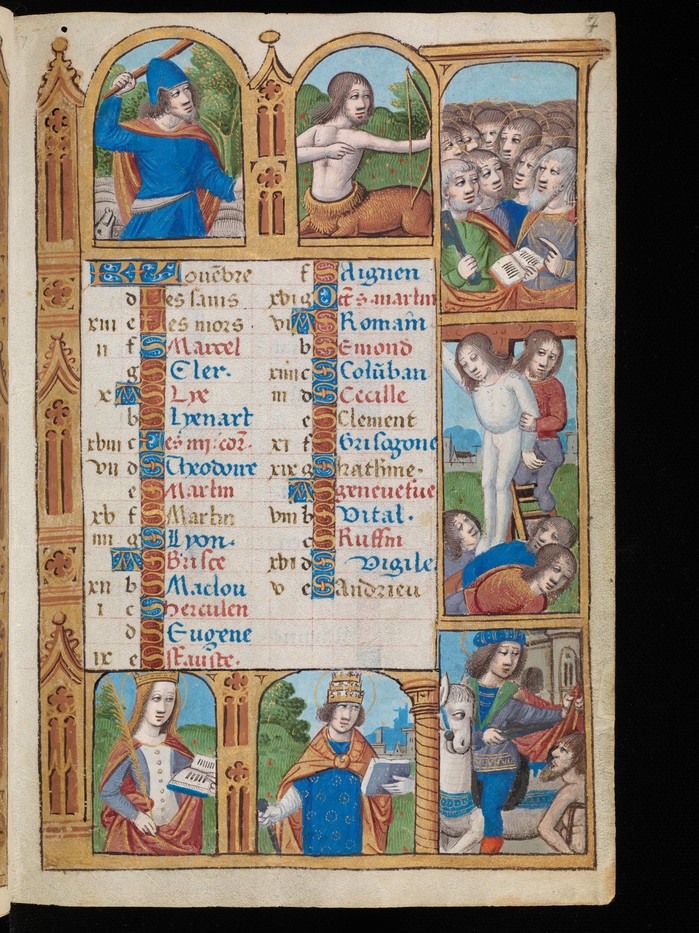
The Utopia, armarium codicum bibliophilorum collection (roughly translates to bookshelf of book-lovers) hosted at e-Codices is the location for privately-held manuscripts who’s owners allowed them to be digitized, but do not wish to be known. From that two books have been recently added, cod.109 and cod.111. Both of these are mid-15th century manuscripts from France, but after that they are distinctly different.
Cod.109 is from Angers, once the capitol of Anjou and about 300km from Paris, and dates from about 1430. It isn’t an unusually beautiful hours, but nicely executed with bright colors and wide borders filled with tiny leaves. The calendar is mostly full, with about 50 empty dates, though there is not a single feast with 2 different saints, not even the common pairing of St. James 1761 and St. Christopher 1757 on July, 25. The error rate is pretty low, only 18, but they seem to come in groups. Some unusual saints seem to reflect the uncommon use, such as St Gratian 3418 (in red) on October 23.
(Db ID: 260)
Another early manuscript from the Walters Art Museum, W.37 is a early 14th C (1300-1310ish) Book made for the Use of Liege, probably for a Beguine living in Huy (Belgium, south-west of Liege). The manuscript has a series of full-page miniatures between the calendar and the Hours of the Nativity of the Virgin, and does not contain the standard Hours of the BVM.
The Calendar is rather bare, with only 160 entries in total. The entries are very accurate in content, none were unidentified and only 2 were on the wrong date, both by a single day. There are several unusual saints, mostly localized to Liege, including Count Mengold on February 8 (4244).
That is not to say that the calendar is without error, however, as there are two sorts of error present. The black entries were penned before the miniatures, and in multiple cases the miniature has over-painted the text. This is most obvious in the later months, in December(see f.8v below) the Nativity of the Virgin is missing the entire last word, due to the Labor of the Month. Additionally the red entries were done by a poor scribe, the hand is extremely shakey and inconsistant. This red-ink scribe neglected to include at least one feast, there is a Vigil for St. Laurence on August 9 (651) but no entry for the feast on the 10th.
(DB Id: 93)
